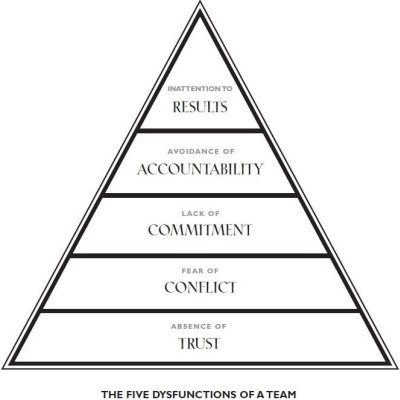Aloha peeps,
I finally have some time at my hand, as I am waiting to be staffed for my next project, to read some books from my list. In my last project, my team had a digital library in which we shared our opinion on books someone must read. One of them was "Overcoming the Five Dysfunctions of a Team: A Field Guide for Leaders, Managers, and Facilitators" from Patrick Lencioni. In my work as a consultant, I got used to joining dysfunctional teams. We are rarely asked to join an organization when everything goes great. Identifying the challenge a team faces is half the battle to solve it, hence I am now read the book. I enjoyed it as the content was easy to understand, and the learnings are presented compactly. If you don't have the time to read the book, follow me along as I am going to share my learnings of the first half of the book and add my thoughts. I am ditching the second half as it's diving into the pitfalls and obstacles facilitators will encounter on their way tackling the dysfunctions in the respected sessions. In the first half of the book we learn about the five dysfunctions, how they present themselves and how they impact a team. I am a software engineering consultant and this content is focused on software delivering teams.
The Absence of Trust
Firstly, the word “Trust” needs to be defined. It's not the ability to predict a team member's behaviour in a certain situation. Trust is all about vulnerability. In retrospectives, the “Prime Directive” is read aloud by one attendee to everyone in the room to remind people to be vulnerable and open to each other. When people are not open to each other, they will likely engage in some kind of political behaviour and not share constructive feedback. Topics will not be discussed in fear to give oneself the nerve in a conversation. Team members that are comfortable with each other are able to say “I was wrong”, “I made a mistake”, “I need help”, “I’m not sure” and “you’re better than I am at that” and yes, even “I’m sorry.”. In order to achieve vulnerability-based trust, meetings must be blameless. Otherwise, people will shut down and avoid discussions in fear of being blamed. Achieving vulnerability-based trust can be done with team building and Speedback sessions. In those sessions, the team members should focus on one positive fact a certain team member brings to the team and one area the team member could be improved. I have had great time in such Speedback sessions, and they also work for remote teams. The book describes another exercise in which the team members share personal historical facts: where they grew up, how many kids were in their family, and what was the most difficult or important challenge of their childhood. This allows the team members to become more open with each other by sharing some intimate facts about themselves. Through empathy, the members are able to let down their guard about their strengths, weaknesses, opinions, and ideas.
KEY POINTS-BUILDING TRUST taken from the book:
- Trust is the foundation of teamwork.
- On a team, trust is all about vulnerability, which is difficult for most people.
- Building trust takes time, but the process can be greatly accelerated.
- Like a good marriage, trust on a team is never complete; it must be maintained over time.
MASTERING CONFLICT
I already teased the second dysfunction in the last section as with missing trust teams tend to avoid conflict. Passionate dialogues around issues and decisions aren't happening. People hesitate to disagree with, challenge, and question one another all because of fear of conflict. The author defines the word conflict with "productive, ideological conflict: passionate, unfiltered debate around issues of importance to the team". Important is that when teams with vulnerability-based trust are discussing, none are trying to win an argument and rather pursuit the truth or e.g. the best solution. Do you remember when you had a discussion lately, where you went out of the meeting only having said half of what you wanted to say and needed to vent about a certain person? Your team is lacking vulnerability-based trust, and you are uncomfortable to share your thoughts. It doesn't mean, though, that conflict should feel too comfortable. I remember from "Crucial Conversation" that when in a discussion, we want to always keep ourselves and others in the sweet spot between "Silence" and "Aggression". The author shares a similar picture to “Conflict Continuum” in which we should operate. Picture yourself young again at the dinner table with a friend's family. If the discussion of your friend's family makes you feel strange as it's unfiltered dialogue without personal attacks, then it's a great discussion. It is not realistic to not make someone uncomfortable within a discussion but with vulnerability-based trust people with understand that rejections aren't based on personal vendettas.
The best way to achieve a good conflict climate is to talk about the team member's conflict profiles. Here is something personal: I never saw my parents fight. I tend to feel uncomfortable around conflict and try to keep it non-emotional, even if that means giving in. The teachings of the Crucial Conversation framework has helped me navigate conflicts and in teams that achieved vulnerability-based trust I feel able to discuss passionately about technology. The book mentioned additional tools like the Depth-Frequency Conflict Model or MBTI to find out the profiles of each member. Another tip mentioned is to create a conflict norm for teams or organizations. In such norms the cultural difference need to be incorporated. Obstacles to perfection could be environmental obstacles (the physical environment where the conflict is taking place), relationship obstacles (an unresolved legacy event between the team members involved), and individual obstacles (an emotional or social deficiency on the part of one particular team member). These obstacles should be acknowledged that it does not continue to cloud the conversation about the real issue.
KEY POINTS-MASTERING CONTLICT taken from the book:
- Good conflict among team members requires trust, which is all about engaging in unfiltered, passionate debate around issues.
- Even among the best teams, conflict will at times be uncomfortable.
- Conflict norms, though they will vary from team to team, must be discussed and made clear among the team.
- The fear of occasional personal conflict should not deter a team from having regular, productive debate.
ACHIEVING COMMITMENT
As software is mostly developed agile, teams tend to choose technology evolutionary. This requires research, discussions, and decisions to be made that teams need to stick too. The third dysfunction of a team is to break with the commitment or to fail at defining the decision clearly. Teams that lack such clarity will leave meetings without or with vague decisions. The seven P's framework is helpful in this regard. I used it in the past to remind myself to think beforehand what kind of product the meeting should produce. This helped me guide the attendees as the facilitator to a well discussed result. Another part of this chapter is about voicing ounces opinion. Teams that are able to voice disagreement are more likely to accept a different outcome when no “right” solution is in plain sight. Sometimes we don't know how things will play out.
KEY POINTS-ACHIEVING COMMITMENT taken from the book:
- Commitment requires clarity and buy-in.
- Clarity requires that teams avoid assumptions and ambiguity, and that they end discussions with a clear understanding about what they’ve decided upon.
- Buy-in does not require consensus. Members of great teams learn to disagree with one another and still commit to a decision.
EMBRACING ACCOUNTABILITY
This dysfunction is pretty straight forward: A team that made a commitment and doesn't stick to it, with team members that don't hold each other accountable. Think of a decision your team has made in a meeting that was controversial and which your team didn't follow through. What will help in this situation is to give critical feedback either in a retrospective or to a team member. This dysfunction can also be about individuals. In my career as a consultant, I had enough instances where the team was implementing some sensible default like test driven development and somebody would not follow through with it. The key to solve this was to understand why the person wouldn't do it and give feedback either directly in the pair programming session or in a 1on1. I can highly recommend the already named “Crucial Conversation” framework if you need help with giving and receiving feedback. Sometimes people just weren't ready as they hadn't been trained our taught a certain concept like TDD and needed to try it out in a safer environment. After providing the time and place for this, the people usually warmed up to the idea of TDD and became interested in it.
KEY POINTS-EMBRACING ACCOUNTABILITY
- understanding the reasons someone is not following through a decision is key to hold someone accountable
- team members should hold each other accountable for commitments, not only a team leader
FOCUSING ON RESULTS
The last dysfunction a team can experience is to lose focus on the results. “Out of sight, out of the mind” is the saying, and this holds truth. Teams need to measure their success and review their KPI regularly. The author advises using dashboards for this, as everyone can check them out at any given time. If your business metrics are not trackable, then make them so. I know these are no features for your shiny product, but this is valuable work. Do me a favour and invest in your team. I have been in too many teams were delivering new features was above such topics. Each team had problems at some point in time, but let's stop here. I don't want to rant about it. The author mentions different types of distractions like the ego, money or career development. Nobody is safe from serving their ego from time to time. This will prevent us though from thinking how we can help other team members or departments of our organization. In this chapter, the author reminds us to think bigger, to think out of the box about results. Maybe your team or your department is performing well. How about the rest of the project or the company? You see a collective wins over a group of people who are more interested in their own individual needs.
KEY POINTS-FOCUSING ON RESULTS taken from the book:
- The true measure of a great team is that it accomplishes the results it sets out to achieve.
- To avoid distractions, team members must prioritise the results of the team over their individual or departmental needs.
- To stay focused, teams must publicly clarify their desired results and keep them visible.
Wow, this was more work than I anticipated. I enjoyed the book, and writing about it made me go back and re-read chapters of it. I learned a lot about dysfunctions of a team. Although I mostly knew how to overcome, it's nice to be able to identify them clearly.
Have a good one, peeps.

